Today's Notables
feast in Bangkok, Part 2
November 2011
Hisashi Furuichi
President and C.E.O.
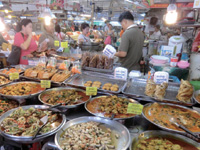
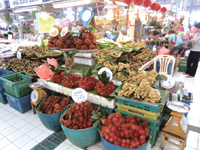
Although we usually hit the historic and famous places on these annual gourmet-walking
tours, our trips are never without a visit to a wholesale market.
These markets always offer ample opportunity to see many foods that
we normally don't see otherwise. It's interesting to see the differences
in culture as it relates to food at these markets.
This time we visited the Aor Tor Kor Market on the third day of
our stay in Bangkok. When I first heard the guide say the name of
the market, it sounded like "otoko ("man" in Japanese)
market" and for a minute, I wondered if they were selling men.
I was surprised to see how clean the market was. The floor was all
tiled and there was not even a hint of garbage laying around. To
compare it to markets in Japan, the Aor Tor Kor Market was at least
as clean as the food markets in department store basements.
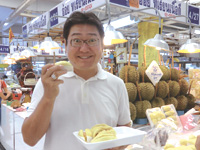
The market sells a variety of exotic fruit. Many fruit that you rarely see were being sold such as the king and queen of fruit, the durian and mangosteen, respectively. The durian is known for the strong odor to the extent that hotels prohibit guests from bringing them in, but a fresh durian does not have such a strong odor. At the market, you can buy a portion of ripe, freshly peeled durian which is served in a styrofoam tray. There are no words for the flavor. . . It looks like a prickly piece of dynamite on the outside and the inside looks like a yellow colored caterpillar. The texture is kind of sticky and clammy. The flavor is nothing like anything I have tasted before so it's hard to describe other than it has a very thick, dense flavor. Some people describe it as a banana that tastes somewhat like cheese, while others liken it more to butter.We also saw a lush variety of tropical fruit such as dragon fruit, papaya, passion fruit, rambutan, longan, and star fruit that are rarely seen in Japan. In addition to fruit, all sorts of various other household dishes, some very spicy looking, were also available.
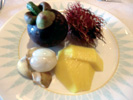 The top left fruit is the queen of fruit, mangosteen. The front left is peeled longan. |
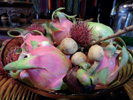 The pink fruit on the front left is dragon fruit. The fruit in the back that looks like sea anemone is rambutan. The potato looking fruit is longan. |
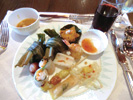 This is dish at the Oriental Hotel restaurant. It was buffet style is lots of choices, all of which were delicious. |

Tropical countries are known to have gradually more spicy food.
The spices were to protect the food against bacteria. Thai food
is not only spicy, there is a quite a bit of sweetness in the spicy
flavor. In Japan's hot summers, we are often advised that we should
take enough sodium and sugar to prevent heatstroke. But this food
is so sweet for the Japanese palette, it makes me wonder if eating
it is really necessary in order to feel good in the heat. Personally,
I prefer spicy food, but lately maybe food has gotten spicier or
my taste buds have become dulled.But on this trip, there was really
only one time when I thought the food was really spicy but most
of the locals thought nothing of it and ate a though they thoroughly
enjoyed it. By the way, spiciness is not really a flavor, it is
a kind of pain caused by receptors of capsaicin in the mouth and
on the tongue, which may be dulled as one ages.
Next year we go back to China again and are thinking about visiting
Fujian Province. It is always fun and interesting to discover something
new as we look for the best tasting food on these travels.
HOME > What’s New > Today's Notables > Details














